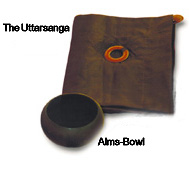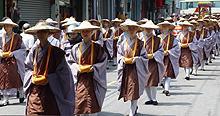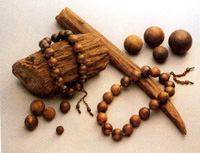| |
◎
An
Introduction to the Sutras and Dharma Instruments
│1│2│3│4│ |
|
(3)Instruments
Used by the Monastics in Their Daily Practices
There are certain requisites that a monastic will always carry as instruments
of daily practices—the “triple robe” (tricivara), the alms-bowl, the staff
(khakkhara), and the prayer beads.
◎“Triple Robe” and Alms-bowl
 |
The
triple robe and the alms-bowl are a monastic's most important requisites,
for he/she can never be found without them regardless of his/her whereabouts.
The so-called “triple robe” consists of the garment (antaravasaka) for
sleeping and working, a robe (uttarsanga) for worshipping and listening
to the Dharma, and a robe (sanghati) for formal Dharma services or functions.
The triple
robe is also known as the “garment of the field of merit” because it is
made with cloth cut in the pattern of paddy fields to signify the planting
of merit field by lay practitioners in making offerings to the monastics.
The monastic robes (kasaya) are symbols of a person who has renounced
home life to become a fully ordained monk or nun.
The alms-bowl
is a monastic's utensil for food and drink. It is also called the vessel
for accepting or collecting since it is the bowl that receives offerings
made by others.
Both the triple
robe and the alms-bowl are symbols of the Sangha's purity symbolizing
the virtues of a practitioner. The so-called “Transmission of the Robe
and the Bowl” refers to the transmission of the triple robe and the alms-bowl,
with the extended significance of the transmission of the Dharma from
the teacher to the disciple.
|
 |
The Thousand-Buddha
Robe (kasaya)/China
|
Female students of Fo Guang Shan
Monastic College on their alms-round to collect alms. |
◎Staff
The staff (khakkhara) is an instrument
carried by a monastic who in the ancient time would use it to scare away
snakes and poisonous creatures, and to announce his presence when seeking
alms. It is capped with metal loops and rings, so a jingling sound will
be heard when shaken.
|
 |
| Ksitigarbha Bodhisattva holding the Sounding Staff |
By wearing the prayer beads, we remind
ourselves to be diligent in reciting and beholding a Buddha's name
and his virtues. |
◎Prayer
Beads
The prayers beads or mala beads are usually worn around
the wrist like a bracelet. They act as a counter for those chanting or
reciting a Buddha's name. A strand of prayer beads usually has either
108, 54 or 21 beads. However, the number of beads is not really that important
in comparison to the sincerity of the reciter, whose attentiveness is
the key to fulfilling his/her wish.
By
wearing the prayers beads around their wrists, the practitioners' main
purpose is to remind themselves to be diligent in reciting and beholding
a Buddha's name as well as practicing the Buddha Path in their daily lives.
C. Further Readings
Do you now have a basic understanding of the Buddhist sutras and Dharma
instruments? If you wish to learn more about Buddhism or anything Buddhist,
please turn your attention to the “Illustrated World Buddhist Arts, Selected
Edition,” which is full of pictures and informative articles, and the
“Fo Guang Textbooks” for an in-depth, yet simple, explanation of the studies
of Buddhism.
|
|
|
| Illustrated World Buddhist Arts, Selected Edition |
Fo Guang Textbooks |
|
|











